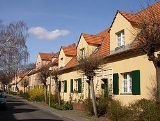
Siemensstadt
Encyclopedia


Charlottenburg-Wilmersdorf
Charlottenburg-Wilmersdorf is the fourth borough of Berlin, formed in the 2001 administrative reform by merging the former boroughs of Charlottenburg and Wilmersdorf.-Overview:Charlottenburg-Wilmersdorf covers the western centre of the City of Berlin...
district of Berlin. It is one of the six Modernist Housing Estates
Modernist Housing Estates
Berlin Modernism Housing Estates consists of six subsidized housing estates that testify to innovative housing policies from 1910 to 1933, especially during the Weimar Republic, when the city of Berlin was particularly progressive socially, politically and culturally...
in Berlin recognized in July 2008 by UNESCO
UNESCO
The United Nations Educational, Scientific and Cultural Organization is a specialized agency of the United Nations...
as a World Heritage Site
World Heritage Site
A UNESCO World Heritage Site is a place that is listed by the UNESCO as of special cultural or physical significance...
.
Geography
Despite its name, the larger part of the estate is situated within the locality (Ortsteil) of Charlottenburg-NordCharlottenburg-Nord
Charlottenburg-Nord is a neighborhood in the northern part of the district Charlottenburg-Wilmersdorf, Berlin, Germany. As of 2008 its population was of 17,327...
, only the smaller westernmost part belongs to Siemensstadt
Siemensstadt
The Siemensstadt Housing Estate is a nonprofit residential community in the Charlottenburg-Wilmersdorf district of Berlin. It is one of the six Modernist Housing Estates in Berlin recognized in July 2008 by UNESCO as a World Heritage Site.-Geography:...
in the district of Spandau
Spandau
Spandau is the fifth of the twelve boroughs of Berlin. It is the fourth largest and westernmost borough, situated at the confluence of the Havel and Spree rivers and along the western bank of the Havel, but the least populated.-Overview:...
.
History
It was built between 1929 and 1931, under the overall master plan of German architect Hans ScharounHans Scharoun
Bernhard Hans Henry Scharoun was a German architect best known for designing the Berlin Philharmonic concert hall and the in Löbau, Saxony. He was an important exponent of Organic architecture....
. Seven prominent Weimar-era architects took part: Scharoun, Fred Forbat
Fred Forbát
Fred Forbát was a Hungarian-born architect with significant work in Germany and Sweden.Forbát was born of Jewish parents in Pécs...
, Otto Bartning
Otto Bartning
Otto Bartning was a Modernist German architect, architectural theorist and teacher. In his early career he developed plans with Walter Gropius for the establishment of the Bauhaus. He was a member of Der Ring...
, Walter Gropius
Walter Gropius
Walter Adolph Georg Gropius was a German architect and founder of the Bauhaus School who, along with Ludwig Mies van der Rohe and Le Corbusier, is widely regarded as one of the pioneering masters of modern architecture....
, Paul Rudolph Henning, and Hugo Häring
Hugo Häring
Hugo Häring was a German architect and architectural writer best known for his writings on "organic architecture", and as a figure in architectural debates about functionalism in the 1920s and 1930s, though he had an important role as an expressionist architect.A student of the great Theodor...
. The nickname Ringsiedlung came from the association of these architects with Der Ring
Der Ring
Der Ring was an architectural collective founded in 1926 in Berlin. It emerged out of expressionist architecture with a functionalist agenda. Der Ring was a group of young architects, formed with the objective of promoting Modernist architecture. It took a position against the prevailing...
collective.
The open spaces were designed by the German modernist landscape architect Leberecht Migge
Leberecht Migge
Leberecht Migge was a German landscape architect, regional planner and polemical writer, best known for the incorporation of social gardening principles in the Siedlungswesen movement during the Weimar Republic...
.
Unlike the other significant public housing projects of the time, which were produced under government cooperative Gehag sponsorship, the Siemensstadt was constructed by a private housing cooperative as worker housing for Siemens' nearby electrical factory, which employed 60,000 workers. The streets and squares of the settlement were named for engineers, physicists and inventors whose performance contributed to the success of Siemens AG.
The shape of the settlement marked a turning point in urban thinking, the point at which Berlin's city planner Martin Wagner
Martin Wagner (architect)
Martin Wagner was a German architect, city planner, and author, best known as the driving force behind the construction of modernist housing projects in interwar Berlin.- Germany :...
abandoned a low-rise, garden city
Garden city movement
The garden city movement is a method of urban planning that was initiated in 1898 by Sir Ebenezer Howard in the United Kingdom. Garden cities were intended to be planned, self-contained communities surrounded by "greenbelts" , containing proportionate areas of residences, industry and...
-style project with individual gardens, in favor of much denser multi-story apartment blocks.
External links
- excellent German-language coverage, with photos
- New York Times, Visionary Design for Berlin's Workers, J.S. Marcus, June 6, 1993
- City of Berlin website on the project, in English

